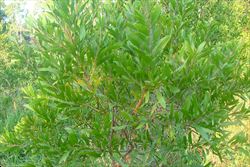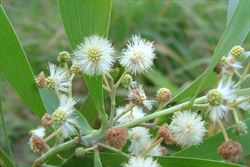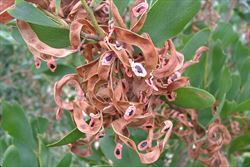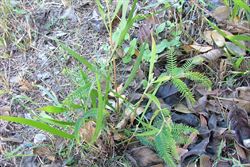Click on images to enlarge

habit of mature tree in flower (Photo: Sheldon Navie)

habit of younger tree (Photo: Sheldon Navie)

fissured bark of a large tree (Photo: Sheldon Navie)

close-up of the globular flower clusters (Photo: Sheldon Navie)

immature fruit (Photo: Sheldon Navie)

mature fruit with seeds (Photo: Sheldon Navie)

close-up of old seeds with large fleshy arils (Photo: Steve Hurst at USDA PLANTS Database)

a young plant growing from a root sucker (Photo: Sheldon Navie)

close-up of the remnant twice-compound leaves on a seedling (Photo: Sheldon Navie)
Scientific Name
Acacia melanoxylon R. Br.
Synonyms
Acacia arcuata Sieber ex Spreng.Acacia melanoxylon R. Br. forma frutescens Hochr.Acacia melanoxylon R. Br. forma melanoxylonAcacia melanoxylon R. Br. var. arcuata (Sieber ex Spreng.) Ser.Acacia melanoxylon R. Br. var. melanoxylonAcacia melanoxylon R. Br. var. obtusifolia Ser.Acacia melanoxylum (R.Br.) Poir.Mimosa melanoxylon (R. Br.) Poir.Racosperma melanoxylon (R. Br.) Pedley
Family
Fabaceae: sub-family Mimosoideae (New South Wales)Leguminosae (South Australia)Mimosaceae (Queensland, the ACT, Victoria, Tasmania, Western Australia and the Northern Territory)
Common Names
Australian blackwood, black wattle, blackwood, blackwood acacia, blackwood wattle, hickory, mudgerabah, Paluma blackwood, Sally wattle, Tasmanian blackwood
Origin
Blackwood (Acacia melanoxylon) is a widespread and often common species that is native to large parts of eastern and south-eastern Australia (i.e. Queensland, New South Wales, the ACT, Victoria, Tasmania and south-eastern South Australia). It ranges from the Atherton Tableland in northern Queensland south through the eastern parts of of this state to the New South Wales border. In New South Wales it is most commonly found along the coast and on the tablelands, but also extends into the eastern parts of the western slopes. It is widespread in southern Victoria, particularly in the Otway Ranges and Gippsland districts, and is also common across most of Tasmania. In South Australia it is restricted to the Mt Lofty and Flinders Ranges.
Cultivation
In Australia blackwood (Acacia melanoxylon) is mainly cultivated as an ornamental species in wetter areas, though timber from natural populations has also long been harvested for its use in wood crafts. The main region where it has been cultivated beyond its native range is in south-western Western Australia.
Blackwood (Acacia melanoxylon) has also been cultivated in forestry plantings in other parts of the world (e.g. in Hawaii, New Zealand, South Africa, Zimbabwe and Sri Lanka). In these and other countries it is used for lumber, fuelwood and also in amenity plantings.
Naturalised Distribution
Naturalised in the coastal districts of south-western Western Australia, from Perth to Albany and Dunsborough. It is also possibly naturalised beyond its native range on the Eyre Peninsula in southern South Australia.
It is also very widely naturalised in other parts of the world, including western Europe (i.e. Belgium, France, Portugal and Spain), Africa (i.e. Ethiopia, Kenya, Lesotho, South Africa, Swaziland and Tanzania), South America (i.e. Argentina, Bolivia, Brazil, Chile, Colombia, Peru, Uruguay and Venezuela), southern Asia (i.e. Bhutan, China, India, Pakistan and Sri Lanka), New Zealand, Hawaii, the west coast of the USA, La Réunion, Mauritius, and the Azores.
Habitat
This species grows naturally in a variety of habitats, but is most common in moist woodlands (e.g. wet sclerophyll forests) and closed forests (e.g. cooler rainforests). It favours the fertile soils of valleys, often in mountainous areas, and prefers clayey and basalt soils. It is commonly found growing along creeks and in north-western Tasmania it also grows as a tall dominant tree in forested seasonal swamps.
In south-western Western Australia it grows in gravelly lateritic soils and is most commonly naturalised in swampy areas.
In South Africa it has become naturalised in forests (particularly in gaps and on the margins) and is also common along waterways and roadsides, in open woodlands and shrublands, and in grasslands. In other parts of the world blackwood (Acacia melanoxylon) has been recorded growing in coastal environs, disturbed sites, urban areas, forest plantations and wetlands.
Habit
Usually an upright tree growing 6-30 m tall, but occasionally a spreading shrub (1.5-3 m tall) in some situations.
Distinguishing Features
- normally a relatively large tree with alternately arranged simple 'leaves'.
- its elongated 'leaves' are straight or curved, with 3-5 prominent veins running lengthwise.
- its pale yellow or whitish flowers are borne in small globular clusters that are arranged in short compound clusters in the 'leaf' forks.
- its elongated pods (4-15 cm long and 3.5-8 mm wide) are strongly curved, twisted or coiled.
- its shiny black seeds are almost encircled by a folded fleshy structure that is pink to dull red in colour.
Stems and Leaves
The bark on older trunks is dark greyish-black in colour, deeply fissured and somewhat scaly. Younger branches are ribbed, angular, or flattened towards their tips and are greenish in colour. These branchlets are usually mostly hairless (i.e. glabrous or glabrescent), but the stems of younger plants are sometimes more obviously hairy (i.e. densely pubescent).
The 'leaves' of this plant are actually flattened and widened leaf stalks (i.e. petioles), and not leaves in the true sense of the word. These modified leaf stalks are called phyllodes, but serve the same function as a regular leaf. On young plants, partially formed phyllodes can be seen which bear twice-compound (i.e. bipinnate) leaves at their tips. As the seedling grows, each new 'leaf' tends to have phyllodes that are more fully formed and the leaves at their tips eventually vanish altogether. However, these remnant twice-compound (i.e. bipinnate) leaves can occasionally be seen on the tips of the phyllodes of older plants (1-2 m or more tall). The dark green to greyish-green phyllodes (4-16 cm long and 6-30 mm wide) are quite variable in shape. However, they are generally somewhat elongated (i.e. narrowly elliptic to lanceolate) and usually about 4-12 times longer than they are wide. They vary from being relatively straight to slightly curved (i.e. sub-falcate) and are usually tapered towards the base. These phyllodes are hairless (i.e. glabrous) with a glossy appearance and a slightly leathery (i.e. coriaceous) texture. They usually have three to five prominent veins running lengthwise and rounded to pointed tips (i.e. obtuse to acute apices). Where the phyllodes join to the stem there is a short slightly thickened flexible joint (i.e. a pulvinus) about 2-4 mm long. There is also a small raised structure (i.e. gland) present on the margin of each phyllode, about 1-10 mm above its base.
Flowers and Fruit
The pale yellow, cream or whitish coloured flowers are fluffy in appearance due to the presence of numerous stamens. They are densely arranged into small rounded clusters (5-10 mm across), each containing numerous (30-56) flowers. Each individual flower in this cluster is stalkless (i.e. sessile) and has five relatively inconspicuous petals and sepals. The flower clusters are borne on stalks (i.e. peduncles) 5-14 mm long and are alternately arranged on a short branch (6-40 mm long) emanating from a 'leaf' fork (i.e. phyllode axil). These compound flower clusters (i.e. axillary racemes) generally contain only 2-8 of the small globular flower clusters. Flowering can occur throughout the year, but is most prominent from spring to early summer (i.e. from September to December).
The fruit is an elongated and somewhat flattened pod (4-15 cm long and 3.5-8 mm wide) that is strongly curved, twisted or coiled. These pods are mostly hairless (i.e. glabrous) and only slightly constricted between each of the seeds. They are green and leathery in nature when young but turn brown or reddish-brown in colour and become more woody as they mature. Each pod contains several very distinctive seeds, and after opening to release these seeds they become twisted and contorted. The seeds are broadly oval (i.e. elliptic) in shape (3-5 mm long and 1.7-3 mm wide), glossy in appearance, and black in colour. They are almost encircled by a large pink, pinkish-red or dark red folded fleshy structure (i.e. aril).
Reproduction and Dispersal
This species reproduces mainly by seed, which are known to germinate prolifically after fire. It also sprouts profusely from root suckers, particularly when the roots and damaged, and readily coppices from damaged stems.
The seeds are spread by animals, particularly birds, and they may also be dispersed in dumped garden waste and contaminated soil. The seed-containing pods are also known to float on water. Root suckers can spread laterally some distance and enable the formation of dense clumps or thickets from a single plant.
Environmental Impact
This garden escape is an environmental weed in south-western Western Australia. While it is not curretly a major problem, it is regarded to be a potentially serious woody weed of swamps and wetlands in this region.
Though blackwood (Acacia melanoxylon) is not yet considered to be a major environmental weed in Australia, it is causing serious problems in southern Africa and other parts of the world. For this reason it is included in the Global Invasive Species Database, where it is listed among a couple of hundred of the world's most invasive species. In South Africa it is a major invader of forests and is a particularly serious threat to 'fynbos' shrubland and grassland areas. It is known to transform these communities by replacing the native non-tree vegetation. It is listed as a declared noxious weed in South Africa, and is considered to be difficult to control there because of its fast growth rate, vigorous regrowth from root suckers, and prolific regeneration from seed.
In the mid 1980's, blackwood (Acacia melanoxylon) was also listed as one of 33 alien species which should be monitored as potential threats to native ecosystems in Hawaii. It has since become invasive in some areas of Hawaii, escaping from forestry plantations into adjacent waterways.
Other Impacts
In other parts of the world blackwood (Acacia melanoxylon) also invades the understorey of relatively open forestry plantations (e.g. pine and eucalypt plantations).
Legislation
This species is not declared or considered noxious by any state or territory government in Australia.
Management
For information on the management of this species see the following resources:
- the Woody Weeds Information Pamphlet on the Environmental Weeds Action Network (EWAN) website at http://members.iinet.net.au/~ewan/.
Similar Species
Blackwood (Acacia melanoxylon) is often confused with other native wattles, particularly lightwood (Acacia implexa) and western coastal wattle (Acacia cyclops).
Lightwood (Acacia implexa), which is also a common and widespread native plant in eastern Australia, has very similar foliage and flowers. It can be distinguished by the smaller whitish-coloured fleshy structure (i.e. aril), that does not encircle its seed, and also by the fact that its young branches are often covered in a whitish powdery substance (i.e. they are usually pruinose).
Western coastal wattle (Acacia cyclops), which is a common native plant in the coastal regions of Western Australia and South Australia, has similar foliage and fruit but can usually be distinguished by its brighter yellow flowers and the brighter coloured (i.e. orange or bright red) fleshy structure (i.e. aril) encircling its seeds.
Note: For a more in-depth key to distinguish between all of the wattles (Acacia spp.) present in Australia, see the Wattle: Acacias of Australia CD-ROM or Flora of Australia, Volumes 11A and 11B.

